Related Research Articles

The biathlon is a winter sport that combines cross-country skiing and rifle shooting. It is treated as a race, with contestants skiing through a cross-country trail whose distance is divided into shooting rounds. The shooting rounds are not timed per se, but depending on the competition, missed shots result in extra distance or time being added to the contestant's total.

Shooting sports is a group of competitive and recreational sporting activities involving proficiency tests of accuracy, precision and speed in shooting — the art of using ranged weapons, mainly small arms and bows/crossbows.

Practical shooting, also known as dynamic shooting or action shooting, is a set of shooting sports where the competitors try to unite the three principles of precision, power, and speed, by using a firearm of a certain minimum power factor to score as many points as possible during the shortest amount of time. While scoring systems vary between organizations, each measures the time of which the course is completed, with penalties for inaccurate shooting. The courses are called "stages", and are shot individually by the shooters. Usually the shooter must move and shoot from several positions, fire under or over obstacles and in other unfamiliar positions. There are no standard exercises or set arrangement of the targets, and the courses are often designed so that the shooter must be inventive, and therefore the solutions of exercises sometimes varies between shooters.
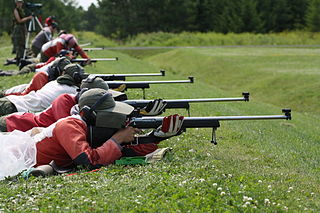
Fullbore Target Rifle (TR) is a precision rifle shooting sport governed by the International Confederation of Fullbore Rifle Associations (ICFRA). The sport evolved as a distinct British and Commonwealth of Nations discipline from Service rifle (SR) shooting in the late 1960s. Its development was heavily influenced by the British National Rifle Association (NRA). Due to this history, it is usually contested amongst the shooting events at the Commonwealth Games, although not at the Olympics. World Championships are held on a four-year cycle. The annual NRA Imperial Meeting at Bisley in the UK is globally recognised as a historic annual meeting for the discipline.

High Power Rifle, also called XTC from "Across the Course", is a shooting sport using fullbore target rifles which is arranged in the United States by the National Rifle Association of America (NRA). The sport is divided into classes by equipment, and popular types of matches include Service Rifle, Open, Axis and Allies and metallic silhouette. The term High Power Rifle sometimes also includes the international shooting disciplines of Palma and F-Class by the International Confederation of Fullbore Rifle Associations (ICFRA) which are represented by the NRA in the United States.
The SIG Sauer 200 STR, also known as the SIG Sauer 200 STR Match, is a bolt-action rifle mostly used as a target/competition rifle for national competitions by Norwegian, Swedish and Danish sport shooters. It is a variant of the Sauer 200 TR or SIG Sauer 200 TR Match rifle that features thicker 19 mm (0.75 in) diameter barrels. The 200 STR is produced by J. P. Sauer & Sohn GmbH in Germany.

Long range shooting is a collective term for shooting disciplines where the distance to target is significant enough that shooter has to put effort into calculating various ballistic factors, especially in regards to the deviating effects of gravity and wind. While shooting at shorter ranges, a shooter only has to slightly adjust the sights to compensate for limited bullet drop at most, but when the range is extended, wind drift will be the first factor affecting precision to the extent that it must be taken into serious account. Some would argue that long range shooting starts where assessment of wind, distance and various atmospheric conditions are equally important for the results as pure shooting skills - meaning that even if one conducts a technically perfect shot, the shooter will miss the target because of incorrect calculations, neglecting to take some elements into consideration, or merely due to unpredictable downrange conditions. It is widely accepted within interdisciplinary circles that for a standard rifle firing full-powered cartridges, "long range" means the target is more than 600 m (660 yd) away,, while "extreme long range" is generally accepted as when the target distance is more than 1,000 m (1,100 yd) away from the shooter.
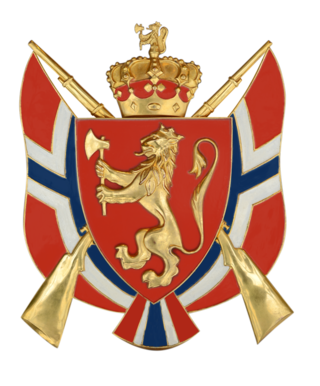
Det frivillige Skyttervesen (DFS), known in English as the National Rifle Association of Norway, and by DFS themselves as the Norwegian Civilian Marksmanship Association since 2020, is a civilian marksmanship association in Norway and the largest shooting sport organization in Norway. It was created in 1893 by Norway's Storting to promote practical shooting skills within the Norwegian people, thereby empowering the national defence. DFS is sponsored by the Norwegian parliament and receives annually about 30 million Norwegian krones to fulfil their purpose. DFS collaborates with various departments in the Norwegian Armed Forces by educating shooting instructors. They also lend their shooting ranges for free to the Norwegian Home Guard. DFS is under the patronage of Harald V of Norway.
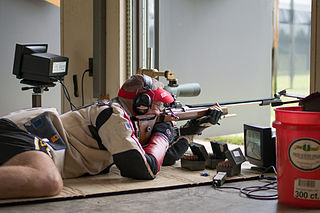
Bullseye shooting is a category of shooting sport disciplines where the objective is to score points with carefully placed precision fire by hitting a target as close to its center as possible. The name refers to the target center's nickname — the "bull's eye". In Scandinavia, this type of shooting competition is referred to as Range-Shooting, as it usually takes place at dedicated shooting range.

The IBU Summer Biathlon is a sporting event organized by the International Biathlon Union (IBU) which combines trail running or roller skiing and rifle shooting, or sometimes trail running and rifle shooting. It is modeled after the IBU (winter) biathlon, which is an Olympic sport that combines rifle shooting with cross-country skiing. The Summer Biathlon World Championships have been held annually since 1990. Trail running was part of the world championships until 2009.
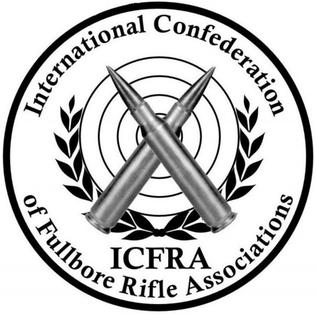
The International Confederation of Fullbore Rifle Associations (ICFRA) is the international association for the fullbore rifle shooting sports of Target Rifle ('TR') (in the US 'Palma' Rifle) and F-Class, which are long range competitions shot at distances between 300 and 900 meters or 300 to 1,000 yards depending on the range. F-Class shooters often shoot concurrently with the world's long-range TR shooters and use the same targets, except that the F-Class target has an extra ring half the diameter of the smallest in use for TR. ICFRA manages the programme of World Championships and other major matches for Fullbore Rifle and seeks to standardize the competition rules for TR and F-Class around the world. In competitions, wind reading skills are important. In order to hit their targets competitors must sense wind direction and speed and adjust their sights accordingly by applying knowledge and experience about wind's effect on the Trajectory of the bullet. World Long-Range Rifle Team and Individual Championships for both TR and F-Class are hosted every four years alternately two years apart. The winner of the World Long Range TR Team Championship is awarded the Palma trophy.
The Target Sprint is a summer shooting sport discipline that combines running and air rifle shooting. It is treated as a race, with contestants running 3 x 400 meters with two rifle shooting sessions in between. The shooting rounds are not timed per se, but missed shots result in time being added to the contestant's total. The athletic sports is run under ISSF
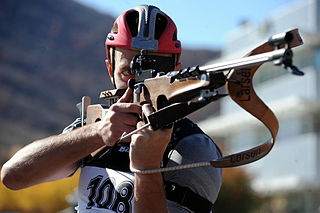
A Biathlon rifle is a specialized rifle designed for use in a biathlon event. Specialist biathlon rifles are ultra lightweight, and usually equipped with straight-pull actions, integrated magazine carriers, and ergonomic stock designs suitable for both prone and standing positions.

The International T-Class Confederation (ITCC), founded in 2014, promotes the shooting sport of T-Class which is mainly focused on competitions with precision rifle systems for various short, medium and long range distances, which may either be known or unknown. Headquarters reside in Bulgaria, and for the purpose of promotion of the sport internationally the organization offers a ruleset which regulates the design and management of competitions.
Nordic field biathlon is a combined cross-country skiing and shooting sport discipline within Det frivillige Skyttervesen. The sport is considered a close predecessor to olympic biathlon, with the main difference being the use of fullbore biathlon rifles and paper targets placed in the terrain with time penalties added for misses. The skiing is usually performed in classic style, while freestyle on is permitted in some races. The number of shots and length of the skiing part can vary. Contrary to the other exercises in the organization, Nordic shooting with cross-country running and Nordic Field Biathlon competitors are divided into male and female competitive divisions.
Nordic shooting with cross-country running or running biathlon is a biathlon sport which combines running and shooting.
SIG Sauer 205 is a bolt-action rifle formerly produced by SIG Sauer. The rifle was produced in several variants for competition shooting and law enforcement.
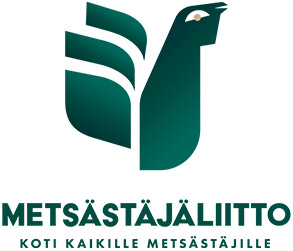
The Finnish Hunters' Association is Finland's largest voluntary association of hunters, consisting of over 2,500 hunting clubs and over 150,000 members. The association was founded in 1921, and today consists of 16 district organizations. Its headquarters are located in Riihimäki. It is a member of the European hunters association FACE as well as the National Defence Training Association of Finland.

100 meter running moose is a shooting sport based on running targets simulating a moose moving sideways.

Biathlon orienteering or orienteering shooting is a multisport consisting of shooting and orienteering. The sport is organized internationally by the International Biathlon Orienteering Federation (IBOF), and is mainly practiced in the Nordic countries as well as a few other European countries. Competitions are organised in Denmark by Danish Military Sports Association (DMSA), in Sweden by the civilian Swedish Multisport Association and in Finland by the Finnish Reservist Sports Federation (FRSF).
References
- 1 2 "Älvsby Shooting Club - The history of moose biathlon". Archived from the original on 2018-08-31. Retrieved 2018-12-13.
- ↑ Piteå-Tidningen - Finns and Swedes win in moose biathlon (Swedish)